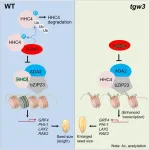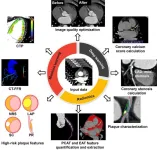(Press-News.org)
Chromatin is the complex of DNA and proteins that makes up the genetic material in the nucleus of eukaryotic cells. A chromatin modifier is a protein or complex of proteins that chemically modifies the structure of chromatin. Chromatin modifiers play a crucial role in regulating the expression of genes, which are segments of DNA strands, as well as in other chromatin-related processes. These modifiers mainly work by adding or subtracting chemical groups to histones, a type of protein within the chromatin, or to the DNA itself.
In the scientific effort to manipulate the expression of plant genes, such as for grain size or drought-resistance, etc., understanding the influence of chromatin modifiers is an important avenue of research.
A team led by Prof. SONG Xianjun from the Institute of Botany of the Chinese Academy of Sciences, while researching a ternary protein complex in rice nuclei that affects grain size, has shown that the transcription factor bZIP23—a protein that regulates the transcription of genetic DNA information into RNA and is part of the ternary complex—recruits the chromatin-modifying histone acetyltransferase HHC4 to specific promoters on the DNA. Furthermore, they discovered that HHC4 and the adaptor protein ADA2 additively enhance the bZIP23 transactivation of target genes.
The researchers also showed that HHC4 is phosphorylated by the GSK3-like kinase TGW3, which triggers a series of negative influences on the capabilities of the ternary complex.
These findings, published in Developmental Cell, contribute to a deeper understanding of the epigenetic regulation of grain size.
A previous study by Prof. SONG showed that GRAIN WEIGHT 6a (GW6a) encodes a newly identified histone acetyltransferase (OsglHAT1) that is a positive regulator of grain size and rice yield.
“At the beginning of this study, we identified five rice homologs of OsglHAT1 on chromosomes 2, 3, 4, and 7 (hence named HHCs) and sought to investigate whether these homologs also modulate grain size,” said Dr. SHEN Shaoyan, first author of the study. "Interestingly, HHC4 regulates grain size but adopts a different cytological mechanism from GW6a."
Using a series of molecular biology techniques, including chromatin immunoprecipitation coupled with high-throughput sequencing (ChIP-seq) and immunoprecipitation followed by mass spectrometry (IP-MS), bZIP23 was shown to directly interact with HHC4.
The bZIP23 gene has been characterized for its role in salinity and drought resistance as well as seed vigor in rice; however, whether it could regulate grain size was unknown. The researchers subsequently discovered that overexpression of bZIP23 significantly increased rice grain size, and bZIP23 and HHC4 co-targeted and synergistically activated the expression of several positive regulators of grain size.
Furthermore, the researchers found that HHC4, ADA2, and bZIP23 interact with each other, and the resulting ternary complex facilitates the additive enhancement of bZIP23 transactivation on target genes by ADA2 and HHC4.
Meanwhile, yeast two-hybrid (Y2H) screening revealed that the GSK3-like kinase protein TGW3 also interacts with HHC4. In addition, the researchers showed that HHC4 is directly phosphorylated by TGW3.
Mutation analysis suggested that two serine residues (S189 and S190) of HHC4 are major sites of phosphorylation by TGW3.
Comparisons with mature grains of transgenic rice plants containing the mimicked phosphorylated and unphosphorylated versions of HHC4 suggested that phosphorylation is involved in grain size control.
Subsequent experimental data showed that phosphorylation exerts many negative influences, such as on the protein stability of HHC4, its interaction with bZIP23, and bZIP23's transactivation of target genes.
In addition, the researchers showed that both HHC4 overexpression and TGW3 knockout substantially increased rice grain yield by up to 24% in field trials.
Overall, these findings uncover a previously unknown chromatin modifier-centered pathway for grain size regulation in rice and provide useful genetic resources for high-yield crop breeding programs.
END
When voters cast their ballots in the 2016 and 2020 presidential elections, many were driven by their concern for climate change, according to new research out of CU Boulder’s Center for Environmental Futures (C-SEF). The new report determined that views on climate change played a significant role in whom people voted for, concluding that the climate issue very likely cost Republicans the 2020 election, all else equal.
“This is obviously information that politicians and advocates across the political spectrum will want to know, heading into the 2024 election cycle,” said Matthew Burgess, CIRES Fellow and C-SEF director. “How ...
This review was jointly published by Prof. Long-Jiang Zhang (Department of Radiology, Jinling Hospital, Affiliated Hospital of Medical School, Nanjing University) and Prof. Christian Tesche (Division of Cardiovascular Imaging, Department of Radiology and Radiological Science, Medical University of South Carolina and Department of Cardiology, Munich University Clinic, Ludwig-Maximilian-University).
With the continuous progress of science and technology, artificial intelligence (AI) has become an important driving force for a new round of scientific and technological revolution and industrial change. It aims to mimic human consciousness and thought processes, continuously ...
AMES, Iowa — Approximately one in three deaths in the U.S. is caused by cardiovascular disease, according to the U.S. Centers for Disease Control and Prevention. A robust body of evidence shows aerobic exercise can reduce risks, especially for people who are overweight or obese. But few studies have compared results with resistance exercise — also known as strength or weight training — or with workout regimens that are half aerobic and half resistance. Researchers at Iowa State University led one of the longest and largest supervised exercise trials to ...
A team of melanoma researchers with the ECOG-ACRIN Cancer Research Group (ECOG-ACRIN) is honored with the 2023 Paper of the Year distinction by the Journal of Clinical Oncology. The recognition is for the results of the DREAMseq randomized phase 3 clinical trial. DREAMseq (EA6134) showed an optimal treatment sequence for combination therapy in patients with advanced melanoma with a BRAFV600 tumor gene mutation. The treatment sequence beginning with immunotherapy (nivolumab and ipilimumab), followed by targeted therapy (dabrafenib and trametinib) if there was disease progression, resulted ...
Rockville, MD (January 16, 2024) – To educate physicians and other health care professionals on the fundamentals of nutrition, The American Journal of Clinical Nutrition has launched a new article series titled Nutrition for the Clinician. The effort supports the White House National Strategy on Hunger, Nutrition, and Health and its directives to expand nutrition knowledge of health care providers, an effort long supported by the American Society for Nutrition. Nancy Krebs, MD, MS, Professor of Pediatrics, University of Colorado ...
Columbia researchers analyzing images from NASA’s James Webb Space Telescope have found that galaxies in the early universe are often flat and elongated, like breadsticks—and are rarely round, like balls of pizza dough. “Roughly 50 to 80% of the galaxies we studied appear to be flattened in two dimensions,” explained Viraj Pandya, a NASA Hubble Fellow at Columbia University, and the lead author of a new paper slated to appear in The Astrophysical Journal that outlines the findings. “Galaxies that look like long, thin breadsticks seem to be very common in the early universe, which is surprising, since they are uncommon among galaxies ...
Consider a group of new sociology students who are about to dive into a completely new subject. Half of them are fresh out of upper secondary school.
They need to settle into student life and get to know other students. They are about to embark on studies in a new field and must learn new ways of acquiring knowledge, regardless of their discipline.
They also need to come to grips with concepts such as legitimation, linguistic objectification, internalization and externalization. What on Earth do ...
A new test invented by University of Illinois Chicago researchers allows dentists to screen for the most common form of oral cancer with a simple and familiar tool: the brush.
The diagnostic kit, created and patented by Guy Adami and Dr. Joel Schwartz of the UIC College of Dentistry, uses a small brush to collect cells from potentially cancerous lesions inside the mouth. The sample is then analyzed for genetic signals of oral squamous cell carcinoma, the ninth most prevalent cancer globally.
This new screening method, which is currently seeking commercialization ...
Women who consume higher amounts of protein, especially protein from plant-based sources, develop fewer chronic diseases and are more likely to be healthier overall as they age, according to a study led by researchers at the Jean Mayer USDA Human Nutrition Research Center on Aging (HNRCA) at Tufts University and published Jan. 17 in The American Journal of Clinical Nutrition.
Analyzing self-reported data from more than 48,000 women, the researchers saw notably less heart disease, cancer, and diabetes, and cognitive and mental health decline, in those who included more protein in their diets from sources such as fruits, ...
Like Indiana Jones, thresher sharks (Alopias spp.) have mastered the art of the whip using their tails. With incredible speed, their long, machete-like tails can slap and stun their prey, allowing them to swallow multiple fish in one fell swoop. Their exceptionally elongated tail, which can often be as long as their entire body, not only makes this particular shark unique, but also a formidable hunter.
Thresher shark “tail-whipping” consists of four phases: preparation, strike, wind-down recovery, and prey collection. Overhead tail slaps begin in the preparation phase by lunging ...






